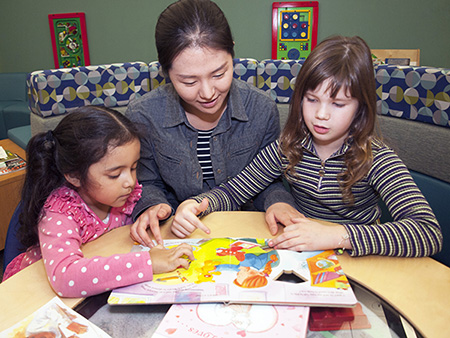"CDD Reads" Program Opens New Doors to Learning and Language Development (IA UCEDD)
November 30, 2015

|
Thanks to a new, multi-media reading program housed within the Center for Disabilities and Development (CDD-Iowa UCEDD) Healy Clinic, patients are developing language skills, increasing interactions with family members, and having fun all at the same time. Entitled "CDD Reads," the program represents a collaboration among four Iowa Leadership Education in Neurodevelopmental and Related Disabilities (ILEND) speech-language pathology trainees, a CDD speech-language pathologist, and two CDD-based programs: the Iowa Program for Assistive Technology (IPAT) and Disability Resource Library (DRL).
The idea for the program grew from a shared passion among all four ILEND speech-language pathology trainees for reaching out to the underserved Spanish-speaking and bilingual Spanish/English speaking communities in Iowa City and the surrounding area. In addition, the trainees recognized the important role joint reading can play in language and early literacy development. Joint reading incorporates activities such as pointing to pictures, asking questions, and talking about parts of the book to foster parent-child interaction. Observing that some parents rarely or never engage in storybook reading with their children, the trainees approached their clinical supervisor, speech pathologist Deb Downey, with a proposal to introduce the concept of joint reading to families during their visit to CDD. Downey secured financial support from IPAT to purchase storybooks and supplemental materials to adapt the books, and in-kind support from the DRL which agreed to house the collection.
The trainees fabricated three sets of 20 English-only adapted storybooks, 15 Spanish-only adapted storybooks, and 20 bilingual Spanish/English adapted storybooks by embedding small visual aids-key vocabulary words superimposed over corresponding pictures-throughout the books. They then fabricated storyboards for each storybook which display all of the visual aids contained within the book and worksheets which guide parents through activities customized for each book to reinforce learning of vocabulary words in fun and interactive ways. The storyboards and worksheets, along with supplies such as a whiteboard and dry erase markers, are contained in an activity case (referred to as a literacy kit) along with up to three books of the child's choosing and made available for checkout from the DRL. Families are asked to complete a questionnaire upon check-out and return of literacy kits, allowing the trainees to track variables such as increases in reading and quality of reading time.
To promote the "CDD Reads" program, the trainees host bi-weekly storybook reading sessions in the Healy Clinic waiting room. They employ the standard "train the trainer" concept to model the use of adapted storybooks, visual aids and parent worksheets to empower parents and caregivers to use the materials at home. Both Downey and the trainees report that the program has been extremely well-received and that literacy kits are in high demand. Based on the program's success, the trainees plan to create a "how-to" make and use video which will be available to families from the CDD website.







